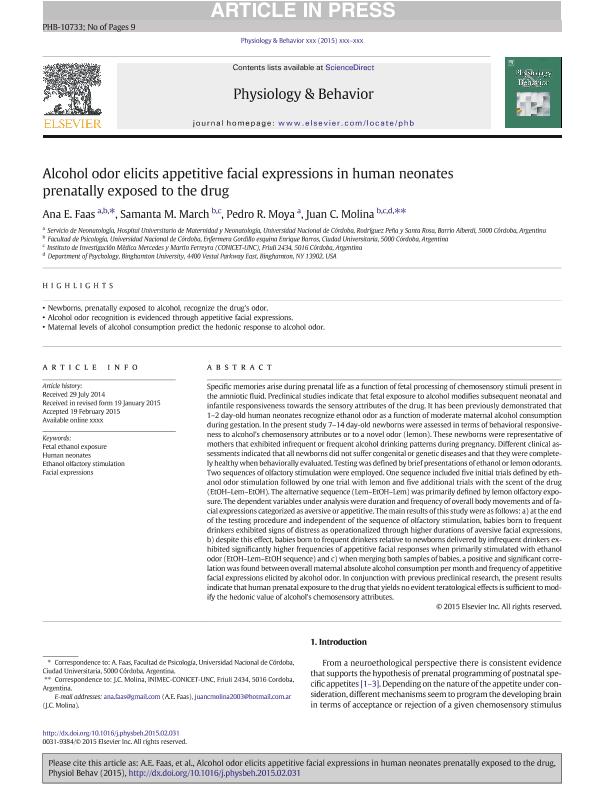Mostrar el registro sencillo del ítem
dc.contributor.author
Faas, Ana Eugenia

dc.contributor.author
March, Samanta Mabel

dc.contributor.author
Moya, Pedro Roberto

dc.contributor.author
Molina, Juan Carlos

dc.date.available
2023-01-27T14:10:26Z
dc.date.issued
2015-09
dc.identifier.citation
Faas, Ana Eugenia; March, Samanta Mabel; Moya, Pedro Roberto; Molina, Juan Carlos; Alcohol odor elicits appetitive facial expressions in human neonates prenatally exposed to the drug.; Pergamon-Elsevier Science Ltd; Physiology And Behavior; 148; 9-2015; 78-86
dc.identifier.issn
0031-9384
dc.identifier.uri
http://hdl.handle.net/11336/185921
dc.description.abstract
Specific memories arise during prenatal life as a function of fetal processing of chemosensory stimuli present in the amniotic fluid. Preclinical studies indicate that fetal exposure to alcohol modifies subsequent neonatal and infantile responsiveness towards the sensory attributes of the drug. It has been previously demonstrated that 1-2. day-old human neonates recognize ethanol odor as a function of moderate maternal alcohol consumption during gestation. In the present study 7-14. day-old newborns were assessed in terms of behavioral responsiveness to alcohol's chemosensory attributes or to a novel odor (lemon). These newborns were representative of mothers that exhibited infrequent or frequent alcohol drinking patterns during pregnancy. Different clinical assessments indicated that all newborns did not suffer congenital or genetic diseases and that they were completely healthy when behaviorally evaluated. Testing was defined by brief presentations of ethanol or lemon odorants. Two sequences of olfactory stimulation were employed. One sequence included five initial trials defined by ethanol odor stimulation followed by one trial with lemon and five additional trials with the scent of the drug (EtOH-Lem-EtOH). The alternative sequence (Lem-EtOH-Lem) was primarily defined by lemon olfactory exposure. The dependent variables under analysis were duration and frequency of overall body movements and of facial expressions categorized as aversive or appetitive. The main results of this study were as follows: a) at the end of the testing procedure and independent of the sequence of olfactory stimulation, babies born to frequent drinkers exhibited signs of distress as operationalized through higher durations of aversive facial expressions, b) despite this effect, babies born to frequent drinkers relative to newborns delivered by infrequent drinkers exhibited significantly higher frequencies of appetitive facial responses when primarily stimulated with ethanol odor (EtOH-Lem-EtOH sequence) and c) when merging both samples of babies, a positive and significant correlation was found between overall maternal absolute alcohol consumption per month and frequency of appetitive facial expressions elicited by alcohol odor. In conjunction with previous preclinical research, the present results indicate that human prenatal exposure to the drug that yields no evident teratological effects is sufficient to modify the hedonic value of alcohol's chemosensory attributes.
dc.format
application/pdf
dc.language.iso
eng
dc.publisher
Pergamon-Elsevier Science Ltd

dc.rights
info:eu-repo/semantics/openAccess
dc.rights.uri
https://creativecommons.org/licenses/by-nc-sa/2.5/ar/
dc.subject
ETHANOL OLFACTORY STIMULATION
dc.subject
FACIAL EXPRESSIONS
dc.subject
FETAL ETHANOL EXPOSURE
dc.subject
HUMAN NEONATES
dc.subject.classification
Neurociencias

dc.subject.classification
Medicina Básica

dc.subject.classification
CIENCIAS MÉDICAS Y DE LA SALUD

dc.title
Alcohol odor elicits appetitive facial expressions in human neonates prenatally exposed to the drug.
dc.type
info:eu-repo/semantics/article
dc.type
info:ar-repo/semantics/artículo
dc.type
info:eu-repo/semantics/publishedVersion
dc.date.updated
2023-01-26T17:35:55Z
dc.journal.volume
148
dc.journal.pagination
78-86
dc.journal.pais
Estados Unidos

dc.description.fil
Fil: Faas, Ana Eugenia. Universidad Nacional de Córdoba; Argentina. Consejo Nacional de Investigaciones Científicas y Técnicas; Argentina
dc.description.fil
Fil: March, Samanta Mabel. Consejo Nacional de Investigaciones Científicas y Técnicas. Centro Científico Tecnológico Conicet - Córdoba. Instituto de Investigación Médica Mercedes y Martín Ferreyra. Universidad Nacional de Córdoba. Instituto de Investigación Médica Mercedes y Martín Ferreyra; Argentina
dc.description.fil
Fil: Moya, Pedro Roberto. Hospital Universitario de Maternidad y Neonatología; Argentina
dc.description.fil
Fil: Molina, Juan Carlos. Consejo Nacional de Investigaciones Científicas y Técnicas. Centro Científico Tecnológico Conicet - Córdoba. Instituto de Investigación Médica Mercedes y Martín Ferreyra. Universidad Nacional de Córdoba. Instituto de Investigación Médica Mercedes y Martín Ferreyra; Argentina
dc.journal.title
Physiology And Behavior

dc.relation.alternativeid
info:eu-repo/semantics/altIdentifier/url/https://www.sciencedirect.com/science/article/abs/pii/S0031938415001055
dc.relation.alternativeid
info:eu-repo/semantics/altIdentifier/doi/http://dx.doi.org/10.1016/j.physbeh.2015.02.031
Archivos asociados
